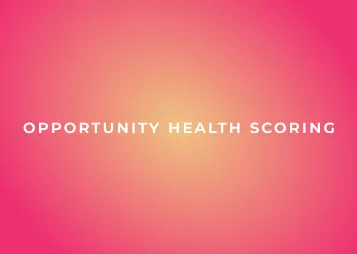60-Second Summary
Sales opportunity health scoring is a structured method for ranking deals in your pipeline based on their likelihood of closing, helping sales and RevOps teams allocate time and resources where they matter most. By assigning scores to opportunities, leaders can improve pipeline management, forecasting accuracy, and coaching effectiveness. Key scoring criteria include: age of opportunity, time in stage, activity levels, stakeholder engagement, conversation data, and competitive landscape. Using conversation intelligence platforms, teams can track sentiment, monitor engagement, and identify risks in real time. Integrating frameworks such as MEDDIC or SPIN Selling into your health scoring ensures structured, data-backed evaluations. For RevOps, health scoring delivers benchmarks that support strategic resource allocation and provide early warning signals when opportunities stall. While automation creates consistency, sales leaders must add human judgment to account for nuance. Done well, opportunity health scoring creates clarity, drives sales team focus, and enables businesses to maximize revenue by prioritizing the highest-value opportunities.
---
Whether you work in sales or not, often you’ll find there are just not enough hours in the day.
Time is precious, and prioritizing your efforts toward the most promising opportunities is crucial for success. Otherwise, it's a waste of time for both Sales and Customer Success to manage.
This is where opportunity health scoring comes into play, a systematic approach to evaluating and ranking your sales prospects based on their likelihood of buying.
By implementing an effective opportunity health scoring system, you can streamline your sales process, focus your energy on the right deals at the right time, and ultimately maximize your revenue.
What is opportunity health scoring?
Opportunity health scoring is a method of assigning a numerical value or score to each sales opportunity in your pipeline. This score reflects the overall "health" or potential of that particular opportunity to convert into a closed deal. It takes into account various factors, such as the prospect's level of engagement, their fit with your product or service, the strength of your relationship, and their progression through your sales process as well as time spent within this process.
Why is opportunity health scoring important?
Opportunity health scoring plays a pivotal role in sales for several reasons:
Prioritization: By identifying the most promising opportunities, you can allocate your time and resources more effectively, increasing your chances of closing high-value deals.
Pipeline management: A well-implemented health scoring system provides a clear and objective view of your sales pipeline, allowing you to make informed decisions about which opportunities to prioritize.
Forecasting accuracy: By regularly updating and analyzing opportunity health scores, you can improve the accuracy of your sales forecasts, enabling better strategic planning and resource allocation.
Coaching and development: Health scores can help identify areas where your sales team may need additional training or support. This allows you to address skill gaps and improve overall performance or just generally discuss an opportunity to get it back on the right path in the short term.
A clear sales process
To effectively implement opportunity health scoring, you need to ensure you have established a well-defined sales process. This process should outline the stages that a prospect goes through, from initial contact to either a closed deal or disqualification. Each stage should have clear entry and exit criteria. This ensures that opportunities move through the pipeline consistently and efficiently and opportunities that should no longer be opportunities are disqualified early in the process to ensure valuable time is not wasted for both parties.
These criteria should be based on objective, measurable factors that indicate a prospect's readiness to move to the next stage or their potential for disqualification.
For example, the entry criteria for the "Discovery" stage might include a completed initial meeting and a confirmed pain point or need that your product or service can address. The exit criteria for this stage could be a clear understanding of the prospect's requirements and a preliminary assessment of their fit with your offering.
As you progress through the sales process, the entry and exit criteria should become more stringent, reflecting the increased commitment and investment from both parties.
How to health score sales opportunities
Opportunity health scoring typically involves assigning a numerical value or score to each opportunity based on a set of predefined criteria. These criteria can include:
Age of opportunity: Opportunities that have been in the pipeline too long will only tie up resources. Find out what is the realistic maximum amount of time an opportunity should be in your pipeline and use this as a benchmark. This should be tracked two-fold by total age of opportunity and time at stage. An old opportunity that has recently moved stage may have been through this process and is now back on track.
Time in stage: Opportunities that have stalled in a particular stage for an extended period may indicate a lack of engagement or interest, potentially lowering their health score.
Activity levels: The amount of activity, such as emails, calls, and meetings, associated with an opportunity can be a strong indicator of its health. More activity generally correlates with a higher level of engagement and interest, so using a platform that allows you to easily see how much activity there is, like a conversation intelligence platform, can be incredibly useful. The number of meetings required to close a deal will vary massively between industries and geographies, so look back at your data to find your own sweet spot.
Conversation data: By analyzing the content of conversations during meetings or calls with conversation intelligence, you can gain insights into the prospect's level of interest, objections, and overall fit with your offering. For example, positive sentiment and alignment with your value proposition can boost an opportunity's health score. Equally, if the prospect is talking more than your rep is talking, this suggests they are engaged, asking lots of questions, and almost ready to buy.
Stakeholder involvement: Opportunities where multiple stakeholders are actively involved and engaged often have a higher chance of success, as they indicate broader buy-in and support within the prospect's organization.
Competitive landscape: Understanding the presence and strength of competitors vying for the same opportunity can influence its health score, as more competition may indicate a lower probability of success.
Using sales methodologies or frameworks as a health indicator
Incorporating a well-established sales methodology or framework into your opportunity health scoring system can provide additional insights and a structured approach to evaluating opportunities. Popular methodologies like MEDDIC or SPIN Selling can serve as valuable reference points for assessing an opportunity's health.
For example, within the MEDDIC framework, you might assign higher health scores to opportunities where you have clearly identified the economic buyer, understood their decision criteria, and established a strong champion within the prospect's organization.
By combining these methodologies with your own unique scoring criteria, you can create a comprehensive and robust opportunity health scoring system tailored to your specific sales process and industry.
Implementing an effective opportunity health scoring system requires ongoing refinement and adaptation. Regularly reviewing your scoring criteria, analyzing closed deals, and seeking feedback from your sales team can help you continuously improve and optimize your approach.
RevOps and opportunity health scoring
RevOps’ role is always to oversee and find ways to improve revenue generation. So health scoring opportunities provides an automated structure that RevOps can benchmark against when assessing pipeline and allocating resource.
The issue of course with health scoring being a black and white, automatic process is that it doesn’t allow for the nuance every opportunity inevitably has. Some things will always require a human touch to truly assess whether they make an opportunity worth prioritizing. But, the health score can be an indicator that a conversation is needed so that you have internal alignment on your opportunities and can add that human factor.
Dan Wilson is the Head of Revenue Operations at Jiminny, implementing new strategies and procedures to improve efficiency, performance, and customer satisfaction across the sales cycle and beyond. With over eight years in operations and five years with revenue teams, Dan has managed and coached teams through numerous challenging situations. He is endlessly passionate about using data, insights and human interactions to drive business decisions and optimize business processes.





.webp)






